Improve Meetings & Change Processes with Visual Facilitation
Visual thinking, learning and collaboration has many faces. That’s why bikablo has been significantly shaping this field of work as a recognized leader, pioneer and development lab for almost 20 years. On this page we explain what Visual Facilitation means, where this role is used, our contribution to this evolving field of work, and (of course) how to become a Visual Facilitator.
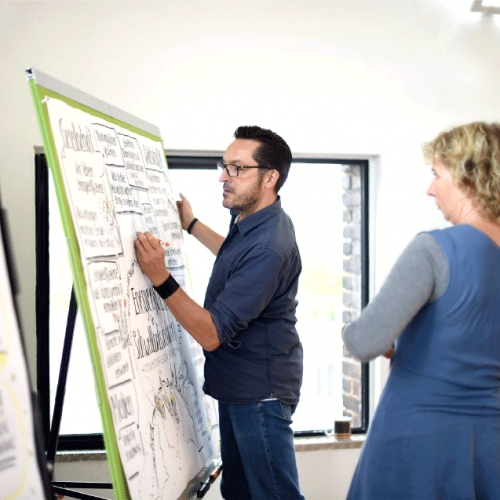
What is Visual Facilitation?
Facilitation means “to accompany” or “to facilitate”. In the context of organizational consulting, group work, meetings, conferences, training, seminars and workshops, the facilitator serves as a conversation support or moderator. So the Visual Facilitator (or Graphic Facilitator) is a process facilitator with a pen. Visualization – that is, “making visible” content and dynamics with graphics, images and text – is a core competence and the basis of a wide variety of conversation tools.
As a “visual consultant” , the visual facilitator also designs entire event plans (activities, breakouts, reflections, etc.) with his clients. These can be large group conferences or change events. Together they plan the use of various visual interventions such as graphic recording and visual storytelling.
The term is more a description of an activity than a specific job description. Many moderators, facilitators, coaches and other professional roles use visual facilitation in their work and identify it as an additional qualification. Some of them concentrate exclusively on working with images and therefore use the term as their own job title.
What distinguishes Visual/Graphic Facilitation from Graphic Recording?
In addition to visual (or graphic) facilitation, other terms have become recognized in the visual thinker/visual practitioner scene. For example, Sketchnoting, Visual Storytelling, Strategy Visualization or Graphic Recording (Visual Recording). Visual Facilitation and Graphic Recording refer to different things: the Visual Facilitator leads group discussions with a pen. In contrast, the Graphic Recorder creates a graphically elaborate visual capture “from the sidelines”. The Graphic Recorder is usually not actively involved in the conversation. Their visual documentations are (so to speak), sketch notes in large format. Ideally (as in bikablo bildwerk’s consulting projects), Visual Facilitators and Graphic Recorders work closely together, for example, in a meeting, a conference or a workshop. On a side note: Visual Storytelling is also different in that it refers to the presentation of content, information and knowledge using visual means, for example in a lecture or training.
The added value of Visual/Graphic Facilitation
The goal of capturing information visually is usually to achieve clarity and a common understanding of the group in group processes. Namely, on concerns, processes, goals or strategies. Why? The group should find solutions in a way that encourages autonomy (not group think) and active participation. To do this, the visual created through their exploration serves as a mirror where everyone can see what has been said at any time and can build on it at any time. To facilitate such a dialogue with the image, a visual facilitator needs special skills. These skills combine drawing, writing, and structuring with traditional moderation methods.
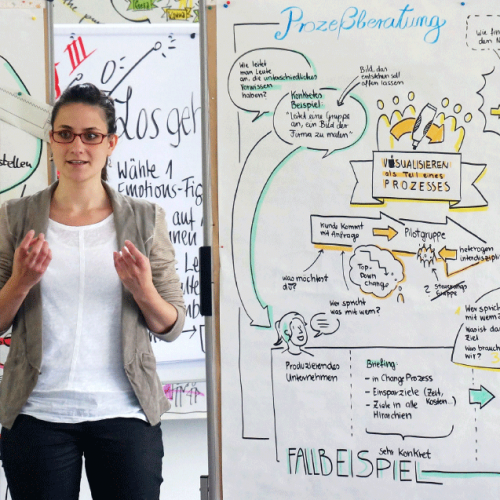
How does visual facilitation work in process facilitation?
The visual facilitator uses a broad repertoire of tools for visual support. For example, these are extensions of traditional interventions: Brainstorming, Metaplan Technique, Mindmapping, Roadmaps and Process Mapping. They can be made more lively, accessible and structured through visual design. What is special about bikablo: we have developed completely new methods. Two examples of our new methods are the coaching intervention called the “Ferris Wheel”, and the creative technique “SymbolSafari” (from our book “UZMO – Thinking With Your Pen”). They focus on the power and emotional innovation potential of images.
In group processes, the visual facilitator usually works live on a flipchart, pinboard or graphic wall. The goal is that all participants can be equally involved. The visual facilitator also passes the pen to the group. In this way, they enable members of the group to express themselves visually. In remote/online facilitation, on the other hand, they design virtual spaces for group and dialog processes with digital visualization tools.
Visual facilitation can be used to accompany a variety of occasions in a participative, creative and solution-oriented way such as: project kick-offs, agile retrospectives, team development meetings, mission statement processes, large group conferences, strategy workshops, co-creation events and design thinking phases for product development.
bikablo as pioneer for Visual Facilitation
bikablo and the bikablo technique (also bikablo visualization technique) originate from the tradition of participatory change processes. After the turn of the millennium we started as visual facilitator and graphic recorder under the flag of the organizational consultancy Kommunikationslotsen. Since 2011, bikablo has existed as its own registered trademark. Since 2015 we have been a separate, globally operating company based in Cologne, Germany.
bikablo bildwerk: consulting services
Our business unit bikablo bildwerk offers a wide range of visualization process supports, consulting and services. Ideally, a bildwerk client project consists of an initial visual consulting phase, followed by a collaborative phase with our team of visual facilitators, graphic recorders and strategic visualizers. This allows us to be responsible and agile throughout the project to effectively support the learning, development and change processes.
bikablo akademie: training
Thousands of aspiring visual thinkers, visual facilitators and graphic recorders have taken their first steps with our basics training. Some of them have gone on to further develop visualization as one of their professional core competencies in our Visual Facilitator Program.
Our courses typically take place as classroom trainings. When possible, we also deliver as online training via Zoom. . We have also developed short learning sessions on specific techniques as video training courses. All formats are available individually to the public and can be delivered in-house for groups as a training strategy professional development.
bikablo products: tools
With the bikablo technique, we have developed a structured language of visual elements that can be quickly learned and adapted to a wide variety of mediums (tablet, paper, whiteboard, flipchart or graphic wall). In our visual dictionaries and learning products, we provide users with our visual vocabulary and templates. In addition, our bestseller “UZMO – Thinking with the Pen” gives a general overview of the world of visual thinking, learning and collaboration and introduces some of the bikablo methods. Over time, all these materials will also be available in a digital format.
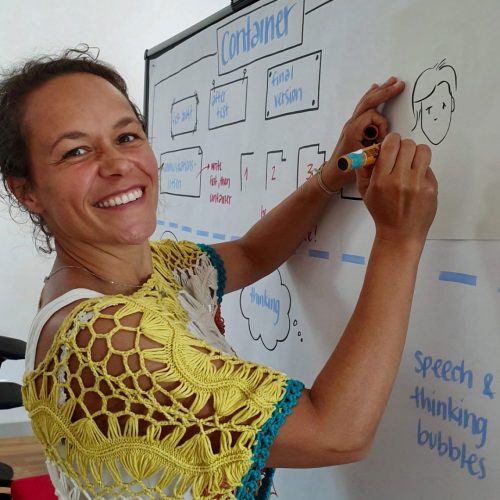
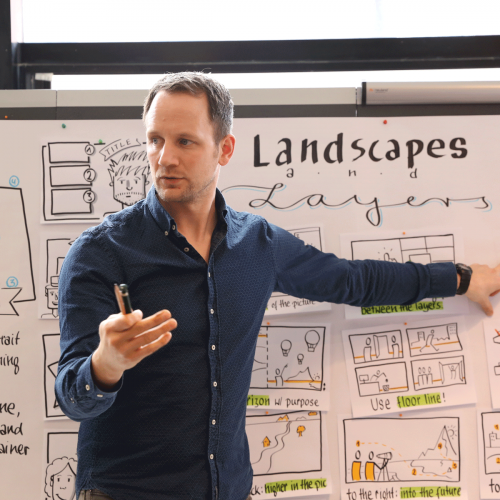
How do I become a Visual Facilitator?
If you want to train as a visual facilitator, we suggest that you first attend a two-day basics training through the bikablo akademie to familiarize yourself with the basics of visual language on flipcharts and pinboards. The next step would be signing up for one of the following modules; Visual Meeting Facilitation, Visual Coaching and Visual Process Mapping of the bikablo Visual Facilitator Program which offers in-depth practical knowledge on a specific focus of work. Here, participants learn valuable applications to use visualization in different meeting situations.
The important thing is: anyone can become a Visual Facilitator! You need a hint of enthusiasm for the visual language and the willingness to learn continuously. On the other hand, previous graphic training is not necessary.
Most Visual Facilitators bring knowledge and skills from coaching, management, training, team leadership, process facilitation, group work or moderation. In most cases, solid training in one of the varieties of process facilitation is the best prerequisite to become a Visual Facilitator.
Why is bikablo the ideal partner for Visual Facilitation?
- We have over 20 years of experience as pioneers in the visual thinking field.
- We’ve worked on hundreds of visualization projects and taught thousands of participants worldwide.
- Our global team is composed of over 60 experienced trainers and visualizers.
- We are industry leaders with our own publications, techniques and methods.
CONTACT BIKABLO
Any questions?
Inhouse trainings:
Carola Keitel
0049 221-98559023
Open trainings:
Julie Junginger
0049 221-98559024
bikablo bildwerk project management & customer consulting
Andrea Biesler and Franziska Schill
0049 221-98559025
You can find support for the bikablo app, online store, video training and digital products on our FAQ page.




MORE ARTICLES ON THIS TOPIC
